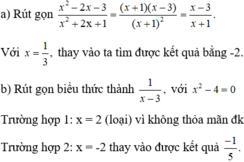(x2-4).(6-2x)=0
Hãy nhập câu hỏi của bạn vào đây, nếu là tài khoản VIP, bạn sẽ được ưu tiên trả lời.


1) Ta có: \(x^2-4x+4=0\)
\(\Leftrightarrow\left(x-2\right)^2=0\)
\(\Leftrightarrow x-2=0\)
hay x=2
Vậy: S={2}

1.
\(x^2-5x+6=0\\ \Rightarrow x^2-2x-3x+6=0\\ \Rightarrow\left(x^2-2x\right)-\left(3x-6\right)=0\\ \Rightarrow x\left(x-2\right)-3\left(x-2\right)=0\\ \Rightarrow\left(x-2\right)\left(x-3\right)=0\\ \Rightarrow\left[{}\begin{matrix}x-2=0\\x-3=0\end{matrix}\right.\\ \Rightarrow\left[{}\begin{matrix}x=2\\x=3\end{matrix}\right.\)
2.
\(\left(x+4\right)^2-\left(3x-1\right)^2=0\\ \Rightarrow\left(x+4-3x+1\right)\left(x+4+3x-1\right)=0\\ \Rightarrow\left(-2x+5\right)\left(4x+3\right)=0\\ \Rightarrow\left[{}\begin{matrix}-2x+5=0\\4x+3=0\end{matrix}\right.\\ \Rightarrow\left[{}\begin{matrix}x=\dfrac{5}{2}\\x=-\dfrac{3}{4}\end{matrix}\right.\)
3.
\(x^2-2x+24=0\\ \Rightarrow\left(x^2-2x+1\right)+23=0\\ \Rightarrow\left(x-1\right)^2+23=0\)
Vì (x-1)2≥0
23>0
\(\Rightarrow\left(x-1\right)^2+23>0\)
Vậy x vô nghiệm
4.
\(9x^2-4=0\\ \Rightarrow\left(3x-4\right)\left(3x+4\right)=0\\ \Rightarrow\left[{}\begin{matrix}3x-4=0\\3x+4=0\end{matrix}\right.\\ \Rightarrow\left[{}\begin{matrix}x=\dfrac{4}{3}\\x=-\dfrac{4}{3}\end{matrix}\right.\)
5.
\(x^2+2x-8=0\\ \Rightarrow\left(x^2+2x+1\right)-9=0\\ \Rightarrow\left(x+1\right)^2-3^2=0\\ \Rightarrow\left(x-2\right)\left(x+4\right)=0\\ \Rightarrow\left[{}\begin{matrix}x-2=0\\x+4=0\end{matrix}\right.\\ \Rightarrow\left[{}\begin{matrix}x=2\\x=-4\end{matrix}\right.\)

\(a.\left(x^2-2x+1\right)-4=0\\\Leftrightarrow \left(x-1\right)^2-2^2=0\\\Leftrightarrow \left(x-1-2\right)\left(x-1+2\right)=0\\ \Leftrightarrow\left(x-3\right)\left(x+1\right)=0\\\Leftrightarrow \left[{}\begin{matrix}x-3=0\\x+1=0\end{matrix}\right.\Rightarrow\left[{}\begin{matrix}x=3\\x=-1\end{matrix}\right.\)
Vậy tập nghiệm của phương trình trên là \(S=\left\{3;-1\right\}\)
\(b.x^2-x=-2x+2\\\Leftrightarrow x^2-x+2x-2=0\\\Leftrightarrow x\left(x-1\right)+2\left(x-1\right)=0\\\Leftrightarrow \left(x+2\right)\left(x-1\right)=0\\\Leftrightarrow \left[{}\begin{matrix}x+2=0\\x-1=0\end{matrix}\right.\Rightarrow\left[{}\begin{matrix}x=-2\\x=1\end{matrix}\right.\)
Vậy tập nghiệm của phương trình trên là \(S=\left\{-2;1\right\}\)
\(c.4x^2+4x+1=x^2\\ \Leftrightarrow4\left(x^2+x+\frac{1}{4}\right)-x^2=0\\ \Leftrightarrow4\left(x+\frac{1}{2}\right)^2-x^2=0\\ \Leftrightarrow\left[2\left(x+\frac{1}{2}\right)-x\right]\left[2\left(x-\frac{1}{2}\right)+x\right]=0\\ \Leftrightarrow\left[{}\begin{matrix}2\left(x+\frac{1}{2}\right)-x=0\\2\left(x+\frac{1}{2}\right)+x=0\end{matrix}\right.\Rightarrow\left[{}\begin{matrix}2x+1-x=0\\2x+1+x=0\end{matrix}\right.\Rightarrow\left[{}\begin{matrix}x=-1\\x=-\frac{1}{3}\end{matrix}\right.\)
Vậy tập nghiệm của phương trình trên là \(S=\left\{-1;-\frac{1}{3}\right\}\)

a: (2x+1)(3-x)(4-2x)=0
=>(2x+1)(x-3)(x-2)=0
hay \(x\in\left\{-\dfrac{1}{2};3;2\right\}\)
b: 2x(x-3)+5(x-3)=0
=>(x-3)(2x+5)=0
=>x=3 hoặc x=-5/2
c: =>(x-2)(x+2)+(x-2)(2x-3)=0
=>(x-2)(x+2+2x-3)=0
=>(x-2)(3x-1)=0
=>x=2 hoặc x=1/3
d: =>(x-2)(x-3)=0
=>x=2 hoặc x=3
e: =>(2x+5+x+2)(2x+5-x-2)=0
=>(3x+7)(x+3)=0
=>x=-7/3 hoặc x=-3
f: \(\Leftrightarrow2x^3+5x^2-3x=0\)
\(\Leftrightarrow x\left(2x^2+5x-3\right)=0\)
\(\Leftrightarrow x\left(x+3\right)\left(2x-1\right)=0\)
hay \(x\in\left\{0;-3;\dfrac{1}{2}\right\}\)

\(x^2-2x-m^2+m-4=0\left(1\right)\)
Để phương trình (1) có 2 nghiệm phân biệt thì:
\(\Delta>0\Rightarrow\left(-2\right)^2-4.\left(-m^2+m-4\right)>0\)
\(\Rightarrow4+4m^2-4m+16>0\)
\(\Leftrightarrow\left(2m-1\right)^2+19>0\) (luôn đúng)
Vậy với \(\forall m\) thì phương trình (1) luôn có 2 nghiệm phân biệt.
Theo định lí Viete cho phương trình (1) ta có:
\(\left\{{}\begin{matrix}x_1+x_2=-2\\x_1x_2=-m^2+m-4\end{matrix}\right.\)
Ta có: \(\left|3x_1\right|-\left|x_2\right|=6\left(2\right)\)
Ta thấy:\(-m^2+m-4=-\left(m^2-m+\dfrac{1}{4}\right)-\dfrac{15}{4}=-\left(m-\dfrac{1}{2}\right)^2-\dfrac{15}{4}\le-\dfrac{15}{4}< 0\)
\(\Rightarrow-m^2+m-4< 0\) hay \(x_1x_2< 0\). Do đó x1, x2 phải trái dấu.
Ta xét 2 trường hợp:
TH1, x1>0 , x2<0. Khi đó:
\(\left(2\right)\Rightarrow3x_1+x_2=6\)
\(\Rightarrow\left(x_1+x_2\right)-6=-2x_1\left(1'\right)\) và \(3\left(x_1+x_2\right)-6=2x_2\left(2'\right)\)
Lấy (1') nhân cho (2') ta được:
\(\left[\left(x_1+x_2\right)-6\right]\left[3\left(x_1+x_2\right)-6\right]=-4x_1x_2\)
\(\Rightarrow\left(-2-6\right)\left[3.\left(-2\right)-6\right]=-4\left(-m^2+m-4\right)\)
\(\Leftrightarrow-m^2+m-4=-24\)
\(\Leftrightarrow m^2-m+4=24\)
\(\Leftrightarrow m^2-m-20=0\)
\(\Leftrightarrow\left[{}\begin{matrix}m=5\\m=-4\end{matrix}\right.\)
TH2: x1<0 ; x2>0. Khi đó:
\(\left(2\right)\Rightarrow3x_1+x_2=-6\)
\(\Rightarrow\left(x_1+x_2\right)+6=-2x_1\left(3'\right)\) và \(3\left(x_1+x_2\right)+6=2x_2\left(4'\right)\)
Lấy (3') nhân cho (4') ta được:
\(\left[\left(x_1+x_2\right)+6\right]\left[3\left(x_1+x_2\right)+6\right]=-4x_1x_2\)
\(\Rightarrow\left(-2+6\right)\left[3.\left(-2\right)+6\right]=-4\left(-m^2+m-4\right)\)
\(\Rightarrow m^2-m+4=0\) (phương trình vô nghiệm)
Thử lại ta có \(\left[{}\begin{matrix}m=5\\m=-4\end{matrix}\right.\)

Bài 1:
a) (3x - 2)(4x + 5) = 0
<=> 3x - 2 = 0 hoặc 4x + 5 = 0
<=> 3x = 2 hoặc 4x = -5
<=> x = 2/3 hoặc x = -5/4
b) (2,3x - 6,9)(0,1x + 2) = 0
<=> 2,3x - 6,9 = 0 hoặc 0,1x + 2 = 0
<=> 2,3x = 6,9 hoặc 0,1x = -2
<=> x = 3 hoặc x = -20
c) (4x + 2)(x^2 + 1) = 0
<=> 4x + 2 = 0 hoặc x^2 + 1 # 0
<=> 4x = -2
<=> x = -2/4 = -1/2
d) (2x + 7)(x - 5)(5x + 1) = 0
<=> 2x + 7 = 0 hoặc x - 5 = 0 hoặc 5x + 1 = 0
<=> 2x = -7 hoặc x = 5 hoặc 5x = -1
<=> x = -7/2 hoặc x = 5 hoặc x = -1/5

\(\Rightarrow\orbr{\begin{cases}x^2-4=0\\6-2x=0\end{cases}}\Leftrightarrow\orbr{\begin{cases}x^2=4\\2x=6\end{cases}}\Leftrightarrow\orbr{\begin{cases}x^2=\left(\pm2\right)^2\\x=6:2\end{cases}}\Leftrightarrow\orbr{\begin{cases}x=\pm2\\x=3\end{cases}}\)
Vậy \(x\in\left\{3;\pm2\right\}\)